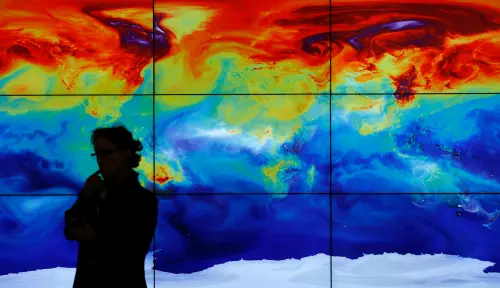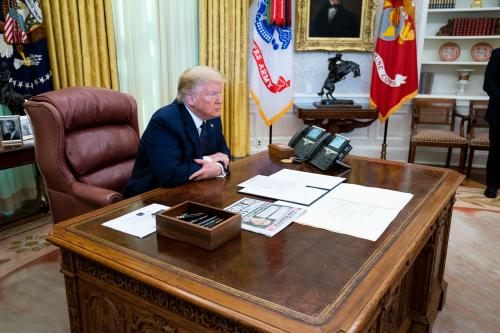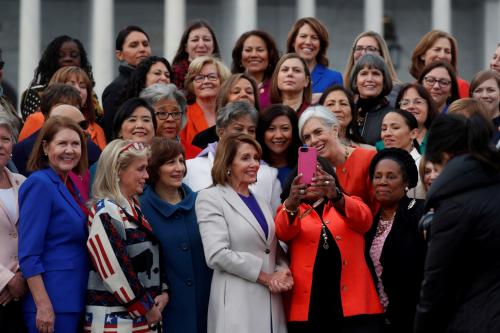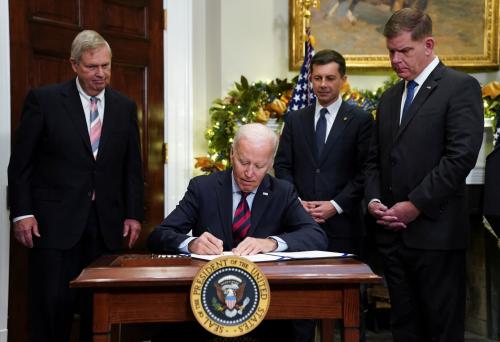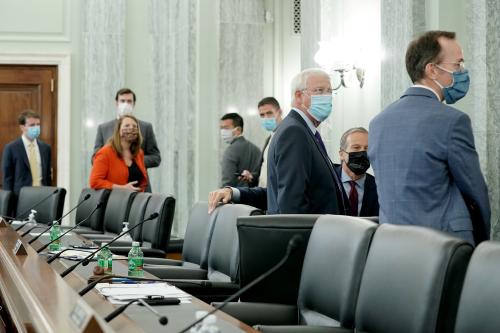This report is part of the Series on Regulatory Process and Perspective and was produced by the Brookings Center on Regulation and Markets.
A major focus of Barack Obama’s administration was reversing the regulatory program of the George W. Bush administration. A major focus of Donald Trump’s administration was reversing the regulatory program of the Obama administration. And a major focus of Joe Biden’s incoming administration will be reversing the deregulatory program of the Trump administration. Back and forth and back again we go.
Well, so what? Isn’t this just part of what we call democratic accountability? Haven’t things always been thus?
While we ought to expect some kind of policy pendulum that tracks changes in partisan control of the White House, the truth is that things have not always been this volatile. The 21st century has been an infamously partisan political era, but regulation itself has also become a far more partisan issue. When we think only about the familiar Bush-Obama-Trump-Biden reversals, we are likely to forget that regulatory state-building forged ahead under Lyndon Johnson and then kept on forging ahead under Richard Nixon, or that old-fashioned deregulation of industries like railroads, trucking, commercial aviation, and financial services began in earnest under Jimmy Carter and continued apace under Ronald Reagan. The rise and reliance on cost-benefit analysis was a thoroughly bipartisan affair. And even in George W. Bush’s presidency, there was more enthusiasm for building on market-based regulatory innovations of the past than for simply targeting the actions taken under Bill Clinton.
Throughout the earlier period, it was taken for granted that enduring regulatory change would be driven, first and foremost, by legislation. Arriving at the compromises that made legislation possible was often hard work; for example, the Clean Air Act Amendments of 1990 came after nearly a decade of Congress putting forth proposals, and the Gramm-Leach-Bliley Act of 1999, which reconfigured American banking law, was the result of a reform campaign that dated back to the 1980s. While presidents and their administrative agencies hardly sat around waiting for these legislative changes to come through, there was nevertheless a presumption that the most significant changes in regulatory programs would have to be rooted in statutory amendments.
Today, however, there is a sense of despair about the prospects for legislative changes to our regulatory programs. Democrats assume Republicans will oppose every regulation, however beneficial; Republicans assume Democrats always want more regulation, whatever its effects on the economy. That mutual suspicion (which is often unfounded) leads presidents and those who would influence them to think almost exclusively in terms of unilateral executive actions, including executive orders, guidance documents, and rulemakings. All of these can reinterpret existing regulatory statutes to align better with the current administration’s policy preferences—but none can actually change the law on the books, which often leads to serious difficulties and protracted litigation.[1]
Climate change policy provides an outstanding, but not entirely anomalous, example of the dynamic that has resulted. After the Democrat-controlled Congress failed to push a climate bill through in 2010, the Obama administration turned to the Clean Air Act to limit greenhouse gas emissions. That law’s language was broad enough to encompass carbon emissions, but at the same time its structure always made it an awkward fit for combating climate change, since its built-in remedies were designed to mitigate localized concentrations of pollution rather than reduce American contributions to global ambient levels of carbon. The administration nevertheless proceeded with a variety of regulatory actions, the most prominent of which was the Clean Power Plan finalized in 2015 but stayed by the Supreme Court in February 2016 pending further litigation. Turning back these Obama climate policies was a major focus of the Trump administration, which first put the Clean Power Plan in suspended animation, then formally rescinded it and replaced it with the Affordable Clean Energy rule in June 2019. Now, those actions are being litigated, and they will probably be held in stasis and replaced by the Biden administration. It seems not entirely far-fetched to imagine that, four years from now, we could see the Biden administration’s rules on this front caught up in the courts, only to be targeted for replacement by the next administration.
This is no way to make policy in the world’s leading economy.
Whatever the policy or legal merits of any of these rules, this is no way to make policy in the world’s leading economy. Regulatory uncertainty is the bane of sound planning and long-term capital investments, of the sort that are crucial in the power sector and others. And yet there no longer seems to be the will in Congress to tackle major regulatory issues. Arguably, we have to go back to the end of the Obama administration for the last major statutory changes to regulation: the Lautenberg Chemical Safety Act of 2016 significantly updated the Toxic Substances Control Act, and Congress passed a law setting up a federal regime for the labeling of genetically modified organisms in the food supply. Perhaps the most significant regulatory change that Congress enacted into law during the Trump administration was a relatively minor amendment to the Dodd-Frank Act aimed largely at easing regulatory burdens on small banks. Regulatory process reforms that many (including me) saw as having bright prospects in Congress never ultimately made it as far as the Senate floor, although some of their substance was later put into effect through executive branch actions.[2]
One might try to defend the status quo by arguing that the broad regulatory statutes already on the books sufficiently empower administrative agencies to update their policies in response to a changing world. In other words, the Environmental Protection Agency (EPA) already possesses ample legal powers to address climate change because it is empowered to protect the general welfare from airborne threats. The Federal Communications Commission (FCC) can regulate new internet technologies as they emerge, because the Communications Act of 1934 is written to encompass all kinds of media, even those unbeknownst to the enacting Congress.
There are surely cases when such executive-led statutory adjustment will be sufficient. But the dizziness induced by our pendulum over the past two decades is itself a sufficient rebuttal to those who argue that our current statutory frameworks are fine just as they are now. Whereas new statutes could put new regulations on a sound legal foundation, reinterpreting old ones inevitably stokes political and legal controversies. The FCC does clearly have broad power—but it is not at all clear that its existing power allowed it to prescribe a rule of net neutrality, as it did in its Open Internet Order of 2015. The Clean Air Act may well give the EPA power to regulate greenhouse gas emissions, but without amendment it cannot give the agency the power to set a universal price on carbon emissions, which is the policy that would best suit the nature of the problem. Lacking statutory amendments, we end up in a world of kludgeocracy, where policies are both poorly designed and politically illegitimate.
But as obvious as the shortcomings of our wildly swinging regulatory pendulum are, the sense that legislation is impossible to push through threatens to become a self-fulfilling prophecy. Well before the election, we have seen would-be advisors of the Biden administration focus on unilateral executive actions. In July, The American Prospect offered “The 277 Policies for Which Biden Need Not Ask Permission.” In August, the Sabin Center for Climate Change Law published a white paper, “Climate Reregulation in a Biden Administration,” which set forth 13 executive actions, dozens of proposals for the EPA and the Departments of the Interior, Energy, and Transportation, and more. It assumed that “a divided Congress” would make legislation unlikely, and therefore focused on the executive branch. I don’t mean to criticize these reports for their focus. Indeed, given the prevailing mindset in Washington, their realism is likely to make them more helpful to policymakers in the new administration. Still, the more that policy entrepreneurs confine themselves to thinking in terms of executive branch actions, the harder it will be to chart a path toward politically durable regulatory policies.
For some areas of regulation, notably including climate, there may well be an unbridgeable divide between the two parties. Although a carbon tax would have many properties to make it appealing to conservatives, especially given the country’s gaping fiscal hole, a deal to put one in place seems hard to imagine at the current political moment. Ironically, many environmental advocates would vociferously denounce any deal that required taking away the president’s ability to make use of the Clean Air Act, which any realistic bargain would require. Whereas in the early part of Obama’s administration, proponents of carbon pricing would readily admit that a jury-rigged system based on the Clean Air Act would be an inferior method of proceeding, they now see such regulations as a source of leverage that ought to be carefully guarded, lest any supposed political bargain fall apart. Our litigious pendulum seems destined to keep on swinging, at least for many policies over which the parties have already dug in their heels.
But in other areas, for all that we now operate with a default assumption of partisan enmity, it is hard to understand why the two parties shouldn’t find a good deal to agree on—in other words, it seems like stopping the pendulum by settling on compromise policies ought to be possible, if only our legislators would give themselves the chance. There remains continued bipartisan support for responsible cost-benefit analysis as the foundation for beneficial regulation, even if many of the Trump administration’s particular cost-benefit analyses were controversial. In a 2014 Brookings paper, I argued that there were a number of promising areas for process reform, including further improving and extending cost-benefit analysis, building Congress’s capacity to understand regulatory developments, and institutionalizing agencies’ efforts to learn from their experience administering their regulations. Even today, “smarter, more efficient regulation” is a banner that both sides ought to rally behind, and there are plenty of opportunities to pursue that program. Some can, and will, be quietly implemented within the Office of Management and Budget and its Office of Information and Regulatory Affairs, where the continuity of career staff ensures that the swings of the pendulum are not quite as dramatic as they may sometimes seem from the outside. But others must await statutory changes that only Congress can deliver.
A good set of regulatory reforms for the 117th Congress to take up immediately would be those relating to the experience of COVID-19. Our awful 2020 has taught some important lessons about our regulatory systems for vaccine development, diagnostic tools, and telemedicine, among many other areas, that transcend partisan identities and therefore ought to create opportunities to escape our familiar back-and-forth dynamic. Looking back at regulatory failures early this year, as Justus Myers and I did in a Brookings timeline, it becomes clear that problems go well beyond particular personnel issues. In a number of cases, regulatory laws meant to safeguard public health actually functioned as obstacles to innovations that might have improved our response during the crucial early months when the virus was spreading. Deregulatory actions undertaken during the pandemic, on the other hand, may point the way to worthwhile permanent changes.
If we were to come through this crisis with a new willingness to put aside fruitless fights about “more” or “less” regulation, and a new sense of urgency about making our regulatory system work for the American people, that would represent a really significant silver lining. Given the apparent deficiency of our regulatory pendulum, it would also be long overdue.


